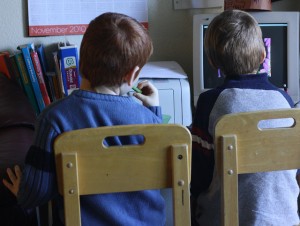Keywords: School-At-Home, Charlotte Mason, Classical, Primary Aged, Preschoolers, Semi-Structured
Children: Two – 8yrs, 4yrs
We get up early as I have animals to feed and house cows to milk. The boys get dressed and eat breakfast and then play or watch TV while I’m outside. I get back in by 8:30am-ish then as a family team we get house jobs done (dishwasher emptied, laundry on and hung, and folded laundry put away, etc). We try to start school by 9:30am but it is sometimes later. We sit down and read the bible and other stories, and work through our memory box. Then my oldest will work on maths (purchased curriculum) while I work with my youngest doing some counting, writing letters and sometimes letter sounds. After that I try to direct my preschooler’s attention to playdough, puzzles, squishy sand, and other self play activities. This enables me to focus on my older child and we move through his other lessons – writing with ease, first language lessons, spelling, reading with narration, and music practice. We are sometimes finished by 10:30am or on occasions it can take us til midday. The afternoon is spent playing together or with friends, doing jobs and shopping. One morning I take my younger son to mainly music while my older boy goes to his grandmother’s to do cooking or craft. Another morning we have swimming lessons but that is later in the morning so we still get school basics done first. We fit sport and art into the afternoons. If I get the basics done – reading, writing and maths – then I’m really happy and if something comes up we let school work go and enjoy the new experience.
Keywords: Unschooling, Single Child, Gifted, Primary Aged, Semi-Structured
Children: One – 9yrs
We started homeschooling because my daughter is profoundly gifted and was bored to the point of acute daily distress, despite attending a highly supportive school where she had been accelerated by two years. Both my husband and I work part time from home and need to have time each day for our paid work. We believe in learning as a “seeded” process of discovery. We have a simple daily routine so we can manage our work hours. We start the day with a family fitness session at 9am (if everybody is out of bed in time!). I start work at 9.30am and my husband spends the morning with our daughter focusing primarily on seeds related to maths, science, technology, communications, media, and music. After lunch, our daughter has personal time while her dad starts his work, and this continues until I am available at 2.30pm. The work I do with our daughter might follow on from ideas developed that morning (eg. researching a related topic in an area of my strengths such as literature or classical civilisation, or doing something crafty connected with the morning’s investigations), or might continue from what we did the previous afternoon, or might start from an unrelated seed (such as a trip to the beach), or may involve a formal class or other structured activity away from home or a playdate. Evenings are often spent watching semi-educational TV as a family, playing games or reading stories aloud to each other. The daily routine varies if my husband needs to be out of the house for his work – sometimes he can take our daughter, but if not then she spends the morning with me in my home office, doing her own quiet work (eg. writing, drawing, maths, English, workbooks, etc). On these days she also has plenty of time to simply sit and read – one of her favourite things of all. We have a “curfew” of 9pm, at which point our daughter heads upstairs so that my husband and I can have some adult time. She rarely goes straight to bed, she normally sits up and reads or plays quietly for another hour or so.
Keywords: School-At-Home, Large Family, Teens, Primary Aged, Preschoolers, Semi-Structured
Children: Seven – 13yrs, 11yrs, 10yrs, 8yrs, 6yrs, 4yrs, 8mths
Our approach to home education follows the School-at-Home model mainly because of our family size and the fact that we stick to a daily routine and a set curriculum for the girls who are ten and over. With our preschoolers we enjoy Learning-Through-Play. A typical day starts at 8:30am with the older girls at the family table. Our curriculum (purchased) has the day’s work organised for us and we basically set out to cover that together. My oldest will often take her work upstairs to her room and check back with me later in the morning. Any science experiments are usually done in the evenings. While I’m with my other two older girls at the table I set reading and writing practice for the younger girls in their exercise books. Once the older girls are working independently the baby goes down for a nap and I focus on the younger children. I read to them and get the ones who can read, reading to me. After that they will do the work I set for them, then they might do a maths lesson on the computer, or a word game. The older girls usually get through a whole day’s work by lunch time, although my oldest has a larger workload to do and will often work into the afternoon. Although our style is rather school-like we have always encouraged a joy of learning and have modeled that for our children. We often drop everything to answer a question or pursue a subject that someone is interested in. Our two preschoolers enjoy learning through play – we have used this method for all of our children and they in turn use it with their younger siblings and children of friends.
Keywords: School-At-Home, Unit Studies, Primary Aged, Semi-Structured
Children: Two – 10yrs, 8yrs
We homeschool using an eclectic approach (curricula for math, planned ‘school time’ for writing, but everything else learning through living and following interests). I am self-employed, my husband works overseas and is home one week per month. I am usually up first and attend to dog, emails and some self-employed business tasks before the girls rise. Once the girls are up we all do morning chores and prepare for the day. We generally fit in a session of either maths or writing before leaving the house for activities. Math or writing ‘table work’ sessions typically last 20-30 minutes. We go out three or four days per week for activities and often add in swimming, a library visit or another unscheduled activity while we are out. Once we come home the other session (of either writing or maths) takes place, sometimes in the evening after dinner when the girls seem to work really well. Monday to Friday I prioritise math, writing and exercise every day. Everything else happens as it comes up. We are all avid learners so there are typically dozens of books being read every month, plus many organic projects on the go at any one time. From time to time we use material such as The Press education papers to direct our learning, but mostly we follow interests and expand on them. I like to use my “three minute snatch” method at the library where I grab a dozen books in a few minutes that I think the girls will find interesting – these are typically non-fiction and cover a very wide range of subjects. From these we search out further resources on topics that really grab our attention. The girls are largely self-directed for much of their time and I fit my self-employed business work around the girls’ table work and activities, as well as working most evenings.
Keywords: School-At-Home, HomeEd/School Mix, Primary Aged, Semi-Structured
Children: Two – 12yrs (at school), 9yrs
We were home educating both children when our oldest asked to go to school. It was not our intention but, after making changes and trying some different approaches to homeschooling, it was the right decision to enrol her into school in the end. It has worked out well for her, it’s probably harder on us having to deal with both school and homeschooling actually. I was contacted by the school twice last year and complimented on our daughter’s sound academic grounding, her respect for teachers and caring attitude towards classmates. It has given us much more confidence in our approach. Our typical day involves dropping my older child to school and then spending the morning doing course work with my younger one. Maths, English and spelling are done every day, with reading and science alternating. Afternoons are spent on extracurricular activities such as sports practice, homeschool swimming classes, dancing, or free play. If we are going out for the day then textbook activities are fitted around this. We have no set finish time. On top of curriculum activities, we do problem-solving games, or design costumes and put on plays (which our older one participates in when she gets home from school). Although we are mainly ‘school at home’ in our approach, I have also taken onboard some ideas from unschooling friends and this has enhanced our homeschooling experience. Instead of set reading activities, if my son finds a book he is interested then we will use that, or we change a topic given in a writing exercise to one that my son is interested in. Although set work from textbooks is usually for 3-6 hours/day (depending on my son’s motivation on that particular day), we also use daily life as an education tool. With our child who is at school, she is used to us being actively involved in her education and willingly accepts our assistance with schoolwork and negotiating classroom politics, and she benefits from being “homeschooled” outside of school hours. We take her out of school for the day if there is something we feel is more beneficial to her education, or if we want to holiday as a family during the school term. Our philosophy was discussed with the school before we enrolled her and they have been very supportive.
Keywords: School-At-Home, Teens, Semi-Structured
Children: Two – 17yrs, 17yrs
This is our last year of homeschooling, the boys have never attended a school. A structured timetable has always worked best for us but we keep things flexible to include ski trips, mountain biking and other activities. With consultation, the boys set up their own work and have mainly focussed on the sciences and maths. They spend 4-6 hours a day studying depending on the curriculum. One of our boys has completed a university paper as a distance course earlier this year and is enrolled in another next semester which involves attendance at classes. Our other son has done two modules of an AutoCAD course at polytech (full time, three days each). We also use some online programs. I expect a 80% pass mark for all tests and assignments. Both boys have part-time jobs at the local supermarket and compete regularly in their chosen sport (soccer and mountain biking).
Keywords: Classical, Charlotte Mason, Unit Studies, Teens, Semi-Structured
Children: Four – 21yrs, 19yrs, 17yrs, 14yrs
We have been home educating for 14 years. My older two are now working and life is very different from when we first started. Would I do it all again? Yes, in a heartbeat. It was one of the best decisions we ever made. As the children have gotten older we have built more flexibility into our schedule. We started homeschooling when the kids were 7yrs, 5yrs, 3yrs, and six months. During this time we usually did five weeks on and one week off, with a longer break part way through the year and at Christmas. A typical day would involve me getting everyone up, dressed and fed; a few chores done, then we’d have devotions and read aloud together (with youngest one back in bed or playing nearby). After that we’d do a mixture of bookwork and activities (eg, maths manipulatives, puzzles, drawing, etc), interspersed with one-on-one time reading on the couch. Then we’d take a break while I fed the baby and did some one-on-one work with the older two. After lunch we would head out to the library, park or an activity such as sports group; or have rest time (reading, audio books, Lego, etc); or outside play. Once the youngest dropped her morning nap she was up at the table with us and loved her school activities. Through the middle years we generally fit in with the school terms but took time off from our usual routines when interesting opportunities came up. This was a very busy time when it was the most hands-on with all the kids’ learning. The day worked best with getting some chores done before starting learning activities. We’d start the day about 9am with devotions and history reading, narrations or activities all together. The kids liked to each have a “Weekly Plan” to follow in the order they chose – with their learning activities for each day listed (eg. maths, reading, spelling, Latin, writing, logic games, music practice, science, or a topic they were interested in). Not every subject was every day. Some days it would say “see Mum” and we’d do it together. Sometimes we’d take a week or month off and do a unit study or lapbooks all together and then do individual maths and music practices. The high school years were where our homeschooling got both messy and exciting! The habits and foundations of the earlier years were really helpful in that the kids had been exposed to a wide variety of experiences and topics, and we had lots of opportunity to see where their strengths and interests lay – they were ready to tackle anything that appealed. Self paced curricula worked really well during the teen years for all of my children. We continued to read aloud and have robust discussions, tackling a mixture of biographies, adventures, classics, tough issues and devotional books. Sometimes I found literature guides helpful to expand our discussions. All my teens continued honing their writing skills independently and as part of a group. Writing was often in the context of research and presentation on topics that interested them. We took advantage of a lot of opportunities such as being ‘model’ students for outdoor education courses, free computing classes at polytech, first aid courses, music opportunities, community night classes, and participation in things available through our church. Volunteering led to part time jobs, and both of my older ones got into tertiary courses based on their portfolio and entrance test.



